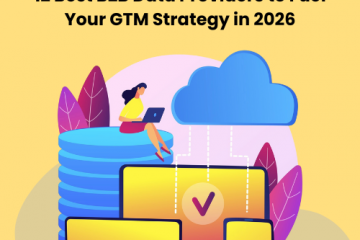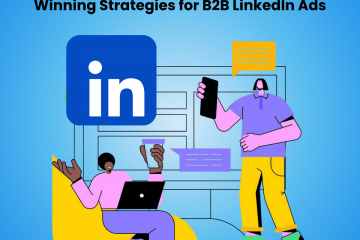Lead Generation Trends Every GTM Leader Must Know in 2025
Lead generation is a familiar yet overused term within virtually every B2B organisation.

However, if you were at our table with a CMO, SDR leader, RevOps leader, and you, we wouldn’t be discussing simply “leads.” We would be asking deeper, more probing questions like:
- What is the reason we’re generating leads that do not convert?
- Why does the funnel continue to leak even after automation has been implemented?
- Why does the buyer feel more distant than ever, even with abundant data at our disposal?
The uncomfortable truth is that the majority of businesses persist with the same strategies for lead generation that were based on older data, rather than 2025 data.
In this piece, we aim to explore what has truly changed in lead generation. What is broken? What has evolved? What do modern GTM teams do differently?
In most organisations striving for serious pipeline growth in 2025, this isn’t just a marketing problem. This is a go-to-market problem, a data problem, and in most situations, a strategic misalignment between sales, marketing, and revenue leaders.
Lead Generation in 2025: Everything Goes Beyond Leads Now
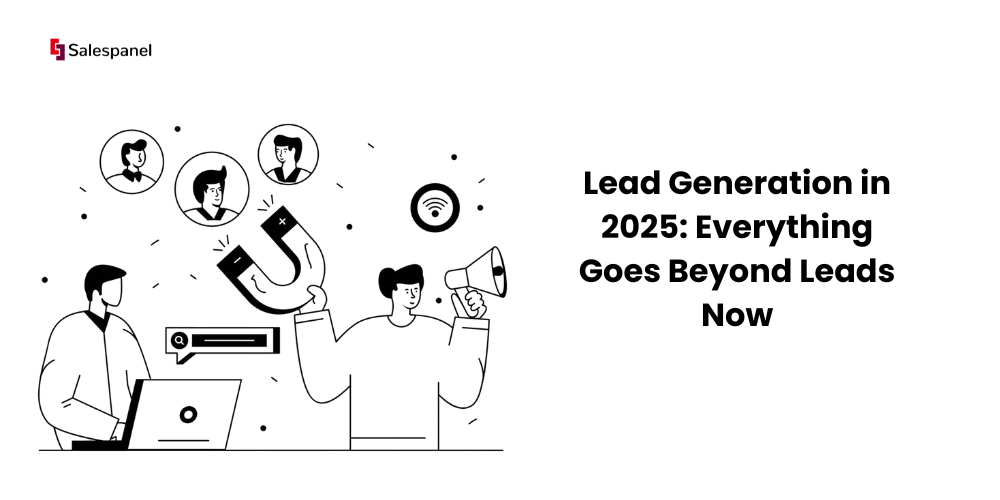
The term “We need more leads” in most cases translates to “We need more pipeline.” In a certain way, the term “lead” was overused in the past. Over the years, it became a simplistic yardstick: a form filled, an ebook downloaded, a lead passed on to the sales team. Easy, right?
But here’s where it gets complicated. The IT ecosystems of most businesses are complex. Every “eligible” lead at some point in the sales funnel did some form of research. And the worst part? They weren’t even, in most cases, the decision-makers.
We are way past 2025, and in the present day, achieving brand objectives doesn’t quite revolve around just gathering names. It is a lot more complex or sophisticated than that. It revolves around figuring out where the buying signals are, who the interested parties are, and doing it all while navigating a multi-stakeholder and multi-channel web.
Why This Shift Matters
Here are some reasons this transformation is critical:
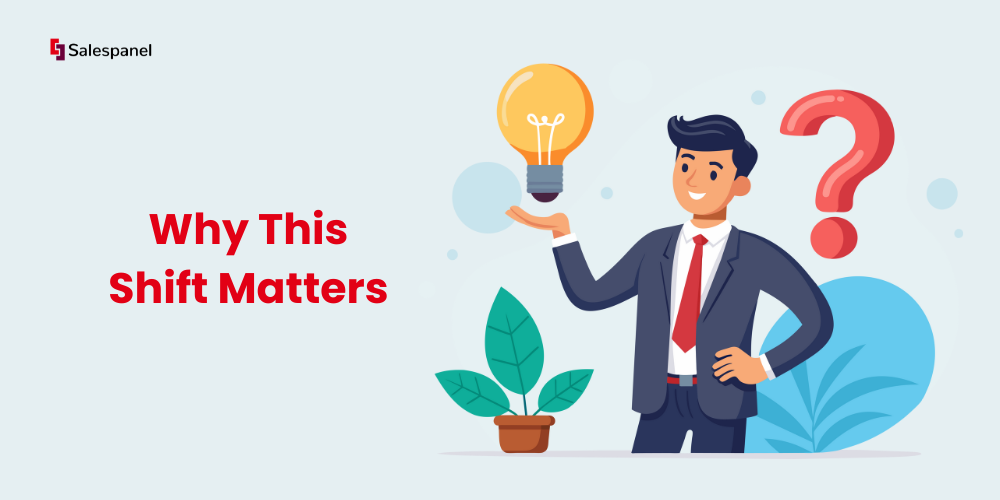
Right off the bat, a potential buyer is doing a majority of the research off the grid. They will most likely not be on the company’s radar and only interact on their own terms.
The same potential buyer is not a singular entity anymore. They are a part of the buying group, a sophisticated web of decision-makers and influencers all operating within one individual account.
Tired and tested lead lists are out, and adaptive classification while taking into account behaviour, suitability, and intent is very much in vogue.
If the last 3 years of your sales cycle have not changed, you are operating outside your ideal customers’ orbit.
What Leaders Are Doing Differently
Smart teams have already begun adapting:
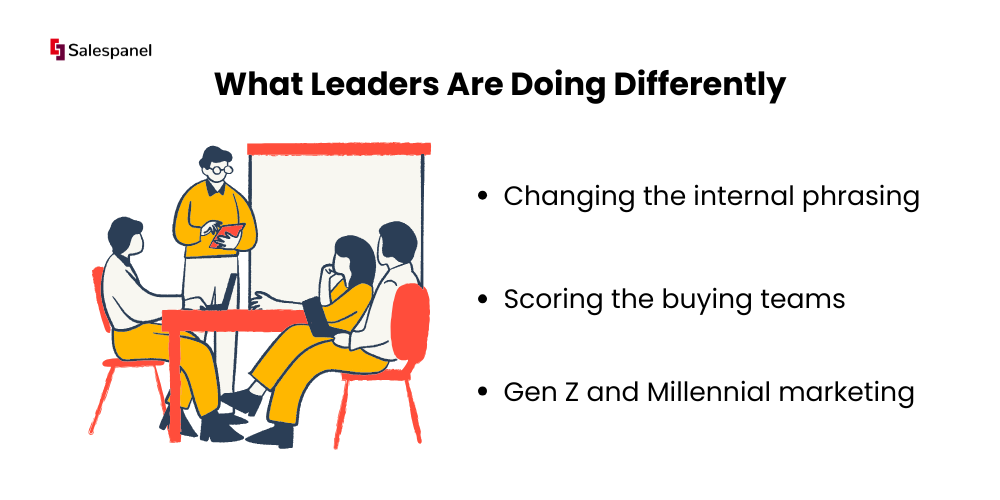
Changing the internal phrasing: Instead of using MQLs, they have shifted to using in-market accounts or high-intent signals.
Scoring the buying teams: Modern GTM teams understand that one contact does not cut it, and they are looking at buying groups and not just individuals.
Gen Z and Millennial marketing: Rather than using content gating as a form of spruiking content, they are using advanced buyer behaviour analytics to dynamically qualify leads.
What You Can Do Starting Today
The good news is that you can begin this transformation immediately:
Do an audit on how your team defines a lead. If it’s email capture-based, that’s the first issue.
Examine your sources of leads. Are they generating buying signals or just useless noise?
Work with sales and RevOps on the definition of “ready” and use that as your new primary target.
The Most Important Changes Impacting Lead Generation Today
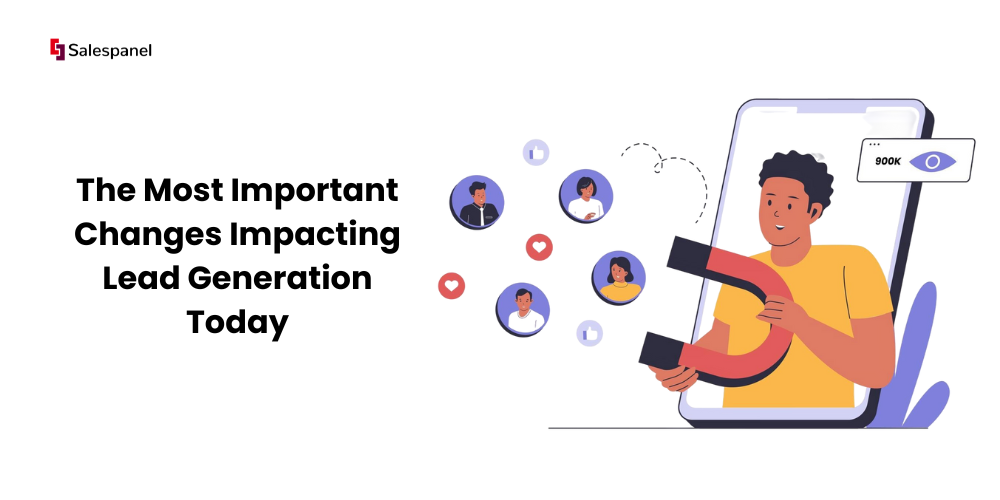
“So if the old way isn’t working, what is?”
Because things have changed, the focus in the last 18 months has been on the best-performing GTM teams. Instead of chasing leads, they have shifted to a more refined and precise approach. Focus is now on speed and intent. Here’s what they’ve fundamentally changed:
Intent Data Isn’t Optional Anymore
As with many things before, intent data, too, has undergone a transformation. Why is that? It is because it reveals who is currently in the market, rather than who downloaded a white paper three months ago.
Current approaches are more focused on “Who is already searching for our services?” as opposed to “Who can be a good fit?”.
Using Bombora, G2, 6Sense, or Salespanel, modern teams are able to track buying signals and prioritise based on real-time prospect behaviour. Because of this, marketing efforts target those with the most intent to buy, and the sales team meets the buyers who are actively looking, which improves productivity immensely.
AI-Powered Personalisation at Scale
The last thing that your prospects want to see is an email from you. AI has enabled communication to be more relevant and useful at a larger scale.
From personalised cold emails to dynamic landing pages and even chatbot-led qualification, AI is enabling teams to engage faster and in a more human-like manner than ever.
Sales and Marketing teams are using AI to tailor communications to the individual buyer’s context and interests. With tools like Clay, Instantly, and AI-powered CRMs, teams are ablex to automate and create customised sequences with dynamic chat and even tailored landing pages, which are as personal as they can get. With this new advancement, engagement rates are increasing significantly while time and effort are being drastically minimised.
Multi-Channel = Mandatory
As of now, you are not using a singular landing page as a funnel to drive and capture customers. As of 2025, the buyer journey will include LinkedIn, Slack communities, webinars, chat, YouTube, and even email.
Understanding this necessity, marketers need to structure these multi-channel strategies and ensure that all messaging is consistent. Take, for example, a prospect who visits a website’s pricing page, then receives a targeted ad, followed by a personalised message on LinkedIn, and then an automated invitation to a webinar. Everything is integrated with marketing automation and CRM.
With this approach, marketers are able to nurture leads and build stronger relationships and trust with them. Lead generation in 2025 relies more on data rather than a simple funnel. The best teams monitor signals and respond with tailored messages across channels to sync with evolving buyer behaviour.
If your team is still focused solely on form fills or lead volume, you are falling behind. Your lead generation strategy must adapt to buyer expectations, which are evolving.
The Privacy Revolution: How Data Collection is Changing
Until recently, tracking and targeting leads had always been a relatively straightforward process. However, the landscape is steadily changing thanks to newer policies and updates such as Google’s phase-out of third-party cookies, Apple’s privacy policies, and the rise of stricter privacy regulations.
What This Means for Your Strategy
Data that you collect through tracking your website and email engagements, as well as through form submissions, is now considered first-party data. This is now your most trusted source for lead insights.
Privacy-enhancing technologies (PETs) anonymise and reverse-DNS identify website visitors without utilising cookies.
Buyers now expect straightforward exchanges for clear communication, building trust. Value exchange, such as exclusive materials or personalised demos, helps garner quality leads.
Retargeting and broad third-party data campaigns lose value as more focus is shifted towards strong first-party audience campaigns and account-based marketing programs built on compliant data.
If your business is lead generation dependent on purchased data lists or reliant on third-party cookies, your business is bound to experience a dip. Privacy-friendly teams with a focus on their own data, who embrace compliant tech, are the only ones who will thrive in this changing landscape.
Where the Best Leads Actually Come From in 2025
To tell the truth, the older “top-of-funnel” channels have changed in importance. There are some tried-and-tested sources that continue to perform. However, the way buyers physically engage with brands has fundamentally changed, and this forces teams to rethink where and how leads can be acquired.
Let’s explore what is working best in the current climate:
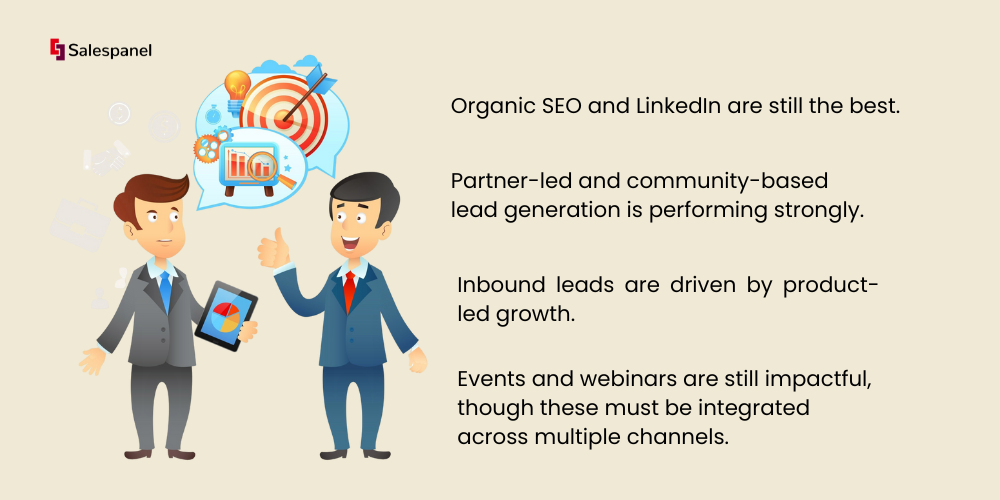
Organic SEO and LinkedIn are still the best. Buyers still conduct their primary research on search engines and on professional networking sites. They expect relevant content from websites, and they can be actively contacted through LinkedIn.
Partner-led and community-based lead generation is performing strongly. An increasing number of businesses are utilising industry partnerships, referral programs, and niche communities on Slack, Discord, and other forums to identify significantly relevant leads.
Inbound leads are driven by product-led growth. Offering freemium models, trials, or self-service demos enables prospects to derive value before engaging with sales teams. Such offerings have the potential to pull in an audience greatly interested in your solution.
Events and webinars are still impactful, though these must be integrated across multiple channels. While hybrid and virtual events are capable of driving engagement, their true value is in how well they are integrated with the larger lead generation ecosystem.
If broad email blasts or paid ads are your primary focus, then it’s time for a strategic change. Modern lead generation focuses on an inbound, relationship-building, product-first approach that relies on data, real-time interactions, and customer engagement.
The AI and Automation Revolution
“If you’re still using manual methods of running after leads or building nurture flows, then you are working way harder than you need to.”
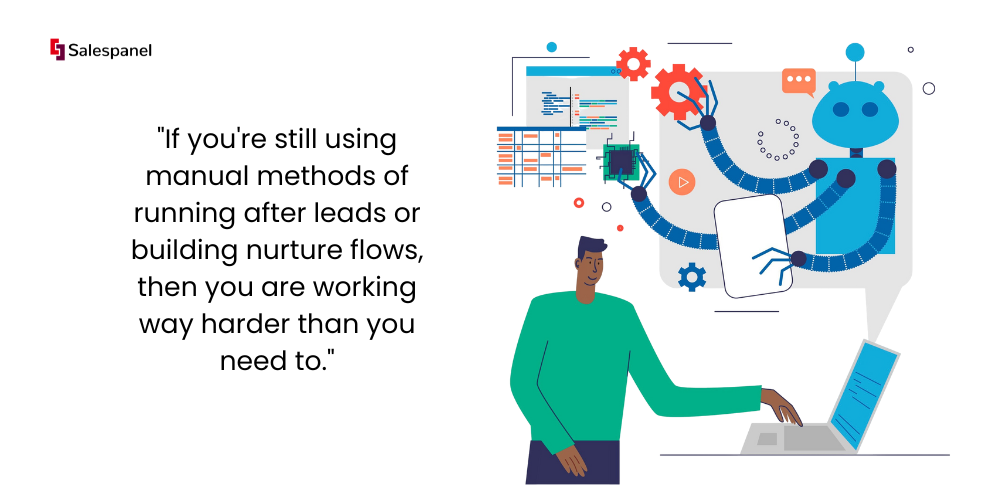
The use of AI to automate engagement, qualification, and nurturing has seen a rapid shift in lead capturing. It’s not just AI hype anymore. Here’s what we can anticipate from 2025 onward:
Conversational AI as the New Front Door
The new front door to businesses is Conversational and Chat AI. Low-value outreach to sales personnel is avoided by bots that qualify attendees in real-time and perform basic functions. They also schedule meetings and handle simple queries.
By 2025, bots and conversational AI are expected to reform the customer service sector and sales meetings completely.
Real-Time Data Synchronisation
AI utilises real-time data syncing across integrated systems. As a result, no lead is lost or goes unmanaged.
The process of a demo request, email, or visiting the website prompts automated actions that update the CRM and trigger the next appropriate step. Marketing tools are expected to offer automated leads, firmographic and behavioural data in real-time action, ensuring no lead data is misplaced or goes untracked.
AI-Powered Personalization at Scale
Generative AI can now automate the personalisation of engaging leads on a whole new level. Preparing hundreds of LinkedIn messages or emails becomes a matter of minutes, allowing SDRs to engage in conversation.
In addition to improving the efficiency of lead qualification, this combination of AI and automation makes lead nurturing more streamlined, ensuring that every prospect receives the right information at the optimal time.
The SEO Disruption: How AI Overviews Are Changing Everything
Having a business listed in the top 3 spots in Google for a particular search term was the go-to strategy for generating new business leads. It guaranteed search volume, brand exposure, and a consistent stream of valuable leads. In 2025, this strategy is out of the window, and most B2B marketers and SEO professionals are still not aware of the extent to which this will affect them.
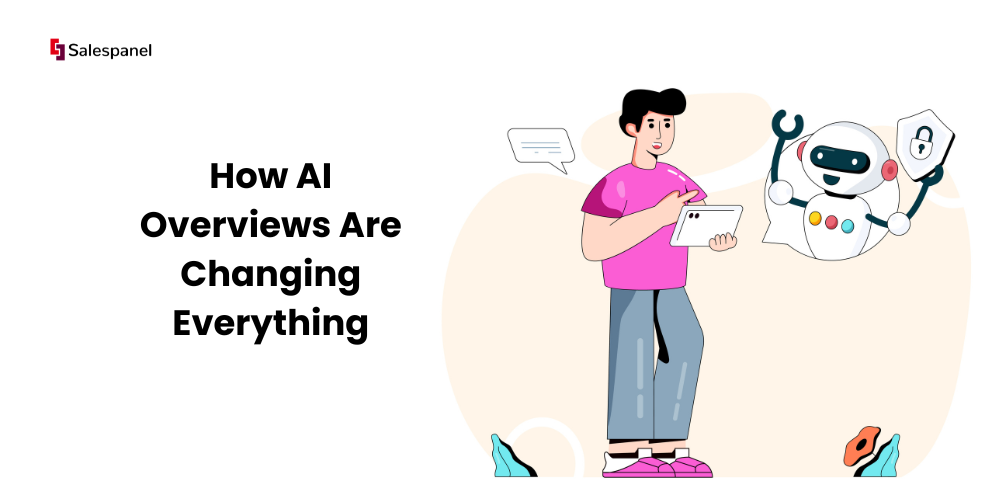
The AI Overview Challenge
With the introduction of AI Overviews, which Google used to call The Search Generative Experience, other search engines, and Google specifically, have started using Generative AI to give answers to users directly in the search box. When responding to a search, AI systems provide summaries and give direct answers to questions. Often, the most relevant answers users are searching for are not only provided in the snippets, but the most relevant URLs are either concealed below the scroll or not displayed at all.
This is where it gets trickier. There’s no reliable method to determine whether your content is being utilised in these summaries. Google Search Console has not reported impressions, clicks, or visibility associated with AI Overview placements. Publishers and marketers are left to wonder: Was my page referenced? Did I receive any traffic related to it? Have I lost potential leads because my page no longer holds any value?
The Impact on Lead Generation
For GTM approaches rooted in organic search, particularly for businesses in content-dense sectors such as SaaS, martech, professional services, and many others, this is not a minor inconvenience. Rather, it is a visibility void. There is a contest to be part of the AI-generated responses, but the parameters, results, and optimisation techniques remain a mystery.
The feeling of the moving ground that the year 2025 brings to marketers will be felt if the brands have been depending on the high ranking in Google for sales prediction.
Tools & Platforms Leading the Way in 2025
“So many tools – how do you identify the ones that make a real impact on lead generation?”
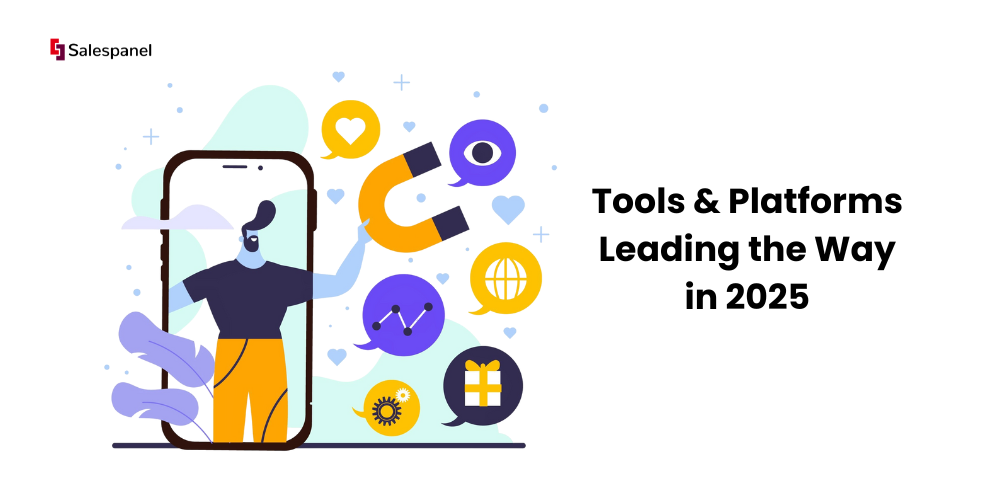
Amidst the chaos of competing platforms, lead generation winners in 2025 will be those who do more than stack tools. They create ecosystems where data flows, and actions are automated in real-time.
Data Providers
Salespanel, ZoomInfo, Bombora, and 6Sense are leading the charge in modern-day lead generation. They provide clean and up-to-date company and contact information, but more crucially, they provide intent data and firmographic information that allows you to prioritise engagements.
For instance, Bombora monitors companies that are researching topics relevant to your solution, and alerts you when they are ready to engage. ZoomInfo enhances your existing leads by providing additional technographic and demographic data, so your outreach is always relevant. Meanwhile, 6sense and Salespanel combine AI and intent data to predict which accounts are in-market and automatically prioritise your highest-value opportunities across the entire buyer journey.
Outreach Platforms
Marketing and sales departments can improve their engagement strategies with the help of Apollo, Instantly.ai, Clay, and Outreach. These tools go beyond simple email scheduling. They analyse interactions, predict optimal email send and reply times, and even use AI-generated content for tailored follow-up emails.
Rather than using emails that feel mass-produced, these systems enable streamlining email sequences that simulate one-on-one interactions.
Lead Capture and Engagement Tools
With advanced tools like HubSpot, Drift, and Intercom, capturing interest and fast engagement with a lead becomes more streamlined. These platforms offer live chat and dynamic forms, alongside real-time engagement analytics. For example, Drift can chat, instantaneously schedule meetings, and even stream hot leads directly to the sales associates, instantly slashing lead drop-off.
ABM Platforms
For B2B organisations practising account-based marketing, platforms such as 6sense, Demandbase, and Metadata.io orchestrate multi-channel campaigns and members within the buying groups. They use intent data, firmographics, and behavioural signals to send messages to the proper roles at the proper time, increasing the chance of a conversion.
The real power comes when these tools talk to each other—feeding data back and forth to you, giving a live picture of where each lead or account stands. Without integration and automation, even the best tools become silos, and that is where leads get lost.
If your stack feels like a mix and a patchwork of many tools, it is time to rethink. Connected ecosystems greatly improve the optimised quality of leads, but also accelerate the time it takes for leads to become dollars.
Metrics That Will Matter in 2025 and Beyond
“Are you tracking the right numbers for your lead generation activities?”
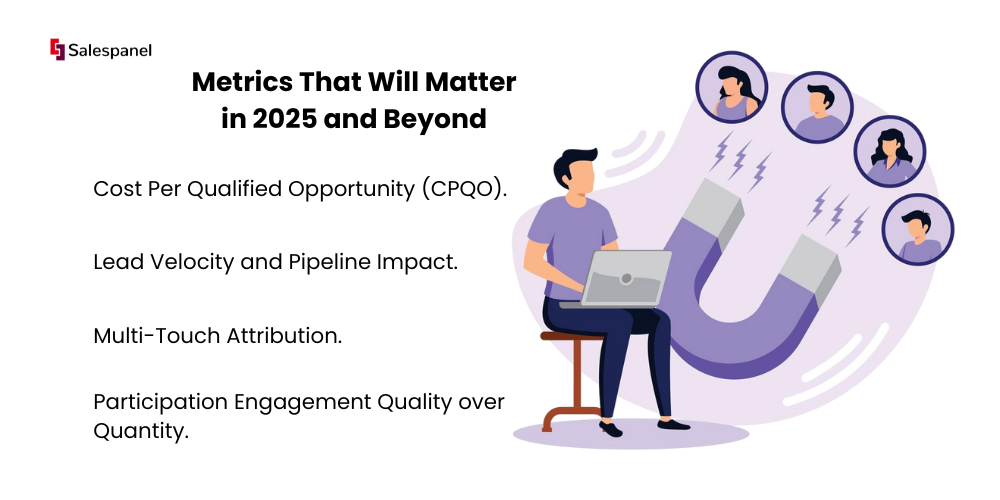
Tracking the success of lead generation has always been challenging, but in 2025, what you choose to measure really could make or break your entire go-to-market strategy. The lead obsession of indiscriminate, unfiltered lead quantity or mere MQL numbers is now a relic of the past and has been rendered obsolete.
In its place, the most successful teams have settled on the following key focal points:
Cost Per Qualified Opportunity (CPQO). This replaces the generic Cost Per Lead (CPL). It shifts the focus to lead opportunities that have a genuine prospect of converting as opposed to any random contact.
Lead Velocity and Pipeline Impact. In this case, leads’ pace and progression within the funnel, as well as their contribution to pipeline growth, take precedence over the total count of leads processed.
Multi-Touch Attribution. The lead’s journey through different channels and interactions, rather than verticals and clicks, is more important than singular last-click attribution.
Participation Engagement Quality over Quantity. Over simple form fills, time spent on site, content consumed, repeat visits, and other behavioural signals are prioritised.
Why does this concern you? Because chasing vanity metrics wastes resources and frustrates teams. Meaningful, outcome-based KPIs align marketing, sales, and revenue operations, which helps you prove ROI with confidence.
The Future: Proactive and Predictive Lead Generation
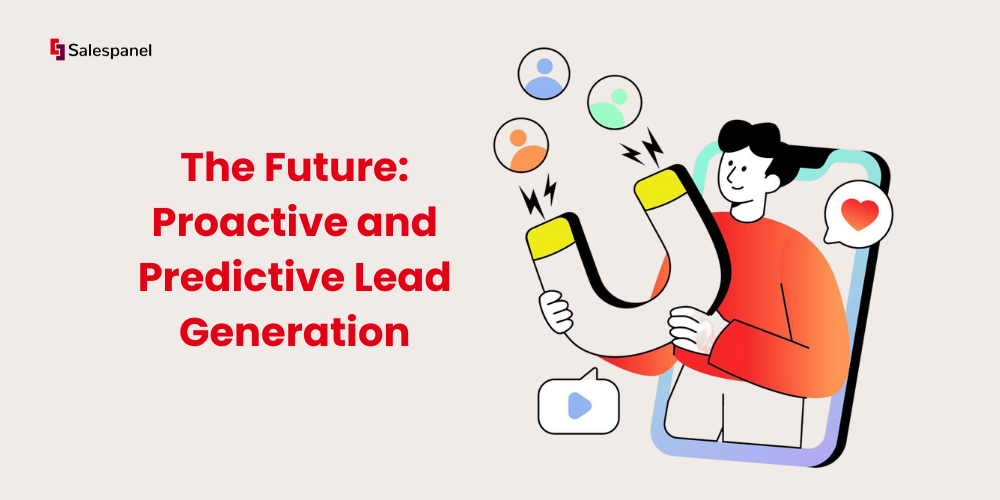
As the market of Lead Generation expands, a common concern pops up: “What else can be done to stay ahead of the competition?”
Companies are shifting gears to adapt to new models of proactive Lead Generation in 2025 and beyond. Reacting to leads once they appear, or trying to “play catch-up”, is no longer a viable business model. Instead, the leads of tomorrow must be predicted and preemptively acted upon.
Predictive Intent Models
Recent technological advances have made it easier to determine which of your key accounts are likely to exhibit buying intent in a day, or which of your target companies have decision-making employees moving towards a decision. Being able to predict the future is not impossible anymore due to the wonders of AI, deep learning, and data interlinking.
Predictive Intent Models can now determine high probability leads out of a complex repository of prospects and predict them based on analyses of buyer behaviour, firmographics, past deals, and other market signals. This streamlines marketing and sales efforts, allowing them to cut down on wasted time chasing prospects who have a lower probability of converting and focus their efforts on those who are likely to close.
Autonomous GTM Agents
As prediction becomes more accurate, proactive engagement becomes the new standard. Proactive engagement can happen in real time and is no longer a time-consuming, manual task. Advanced AI-powered GTM Stacks, which serve to automate and integrate marketing and sales, give rise to “autonomous GTM agents”. These agents can now initiate personalised campaigns, outreach sequences, or sales alerts in real time based on signals.
The ultimate aim of these “autonomous GTM agents”, of course, is to enable the delivery of the right message to the right person, and the right message.
Applying data, technology, and even understanding people all allow for smooth operation that, when combined, drives pipelines with great success. Predicting future trends with higher accuracy enables you to strategically chase opportunities that deliver the highest value. This allows you to outpace the competition.
Summary and Key Takeaways
Let’s conclude today’s discussion by reexamining how AI has already started to change the process of a lead, going all the way to a future where AI can accurately predict the intent of a buyer. We can all agree that:
Leads are now considered to be signals instead of names. Static form fills are now obsolete, replaced by dynamic behaviour-driven segmentation.
The new baseline of effective lead generation has shifted to the new privacy-first strategies and cookieless tracking.
The top sources to fuel a pipeline are now Organic SEO, LinkedIn, community and partner channels, and PLG.
Leads can now be tailored and delivered to a target individual with AI and automation, which in turn enriches the lead.
Real ROI can now be accurately measured by outcome-focused metrics that are used in proving ROI, such as CPQO, lead velocity, and multi-touch attribution.
A real-time go-to-market machine can now be achieved by the right ecosystem of tools spanning all the way from data providers to ABM platforms.
Anticipatory engagement is the new reactive with proactive lead generation that is bound to come in the near future.
Why This Matters to You
Holding on to the tactics you used a few years back will result in losing relevance in a fast-paced and trust-demanding market. Modern buyers interact with brands expecting rich, contextual engagements, and they definitely do not have patience for generic outreach.
Adopting these trends and tactics will help you:
- Refine and unify your marketing, sales, and RevOps teams to be focused on what truly drives the pipeline.
- Shift your attention towards high-intent engagements and opportunities instead of flooding the funnel with unqualified leads.
- Embrace trust by protecting privacy and engaging with stakeholders meaningfully.
- Integrate automated (read ‘Agentic’) playbooks and predictive insights to safeguard your GTM strategies today.
The future of lead generation isn’t just about collecting more contacts, it’s about building intelligent, predictive systems that connect with the right buyers at precisely the right moment. The companies that understand and implement these changes today will be the ones dominating their markets tomorrow.
Sell more, understand your customers’ journey for free!
Sales and Marketing teams spend millions of dollars to bring visitors to your website. But do you track your customer’s journey? Do you know who buys and why?
Around 8% of your website traffic will sign up on your lead forms. What happens to the other 92% of your traffic? Can you identify your visiting accounts? Can you engage and retarget your qualified visitors even if they are not identified?
